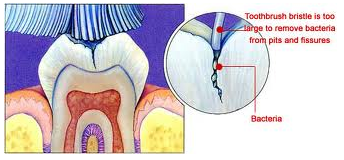Tips for children's dental health
Once teeth begin to appear in the mouths of children, care must also begin. Bearing in mind we offer some tips for dental health of children .
For those who just have the first tooth , it is recommended to be cleaned with a cotton or cloth. As their number increases to use a soft toothbrush and special toothpaste for children , because adult products may cause stains on the teeth of children by their high content of fluorine, in part because they have not learned to spit properly, keeping your mouth product quantities greater than those needed for dental cleaning .
As to the first visit to the dentist, the American Academy of Pediatric Dentistry used to be told it was about 3 years, however, given that many children already have tooth decay when they start their school years, the council has changed to make this visit six months after the onset of the first tooth and no later than twelve months.
Some children may be more likely to suffer tooth decay , for example those who tend to sleep with objects in their mouths or who remain most of the day using a cup or other receptacle for fluids. In these cases, preventive visits to the dentist will take place every 6 months. In lower-risk cases, the doctor will be responsible for recommending the frequency.
Another risk factor that should be taken into account is the inheritance. If the relatives of the child or the child has had recurrent bouts with dental diseases, is advised to visit the specialist every 6 months so that, if they occur, detect such problems early.
The most important thing is to pay attention to the way teeth come and make appropriate follow-up, better yet if this is done by a dentist specializing in pediatric dentistry.
Fluoride Treatment
Fluoride is the most effective agent available to help prevent tooth decay. It is a mineral that is naturally present in varying amounts in almost all foods and water supplies. The benefits of fluoride have been well known for over 50 years and are supported by many health and professional organizations.
Fluoride works in two ways
Topical fluoride strengthens the teeth once they have erupted by seeping into the outer surface of the tooth enamel, making the teeth more resistant to decay. We gain topical fluoride by using fluoride containing dental products such as toothpaste, mouth rinses, and gels. Dentists and dental hygienists generally recommend that children have a professional application of fluoride twice a year during dental check-ups.
Systemic fluoride strengthens the teeth that have erupted as well as those that are developing under the gums. We gain systemic fluoride from most foods and our community water supplies. It is also available as a supplement in drop or gel form and can be prescribed by your dentist or physician. Generally, fluoride drops are recommended for infants, and tablets are best suited for children up through the teen years. It is very important to monitor the amounts of fluoride a child ingests. If too much fluoride is consumed while the teeth are developing, a condition called fluorosis (white spots on the teeth) may result.
Although most people receive fluoride from food and water, sometimes it is not enough to help prevent decay. Your dentist or dental hygienist may recommend the use of home and/or professional fluoride treatments for the following reasons:
- Deep pits and fissures on the chewing surfaces of teeth.
- Exposed and sensitive root surfaces.
- Fair to poor oral hygiene habits.
- Frequent sugar and carbohydrate intake.
- Inadequate exposure to fluorides.
- Inadequate saliva flow due to medical conditions, medical treatments or medications.
- Recent history of dental decay.
Remember, fluoride alone will not prevent tooth decay! It is important to brush at least twice a day, floss regularly, eat balanced meals, reduce sugary snacks, and visit your dentist on a regular basis.
Sealants
A sealant is a thin, plastic coating applied to the chewing surface of molars, premolars and any deep grooves (called pits and fissures) of teeth. More than 75% of dental decay begins in these deep grooves. Teeth with these conditions are hard to clean and are very susceptible to decay. A sealant protects the tooth by sealing deep grooves, creating a smooth, easy to clean surface.
Sealants can protect teeth from decay for many years, but need to be checked for wear and chipping at regular dental visits.

Reasons for sealants
Children and teenagers As soon as the six-year molars (the first permanent back teeth) appear or any time throughout the cavity prone years of 6-16.
Adults Tooth surfaces without decay that have deep grooves or depressions.
Baby teeth Occasionally done if teeth have deep grooves or depressions and child is cavity prone.
What do sealants involve?
Sealants are easily applied by your dentist or dental hygienist and the process takes only a couple of minutes per tooth.
The teeth to be sealed are thoroughly cleaned and then surrounded with cotton to keep the area dry. A special solution is applied to the enamel surface to help the sealant bond to the teeth. The teeth are then rinsed and dried. Sealant material is carefully painted onto the enamel surface to cover the deep grooves or depressions. Depending on the type of sealant used, the material will either harden automatically or with a special curing light.
Proper home care, a balanced diet, and regular dental visits will aid in the life of your new sealants.

